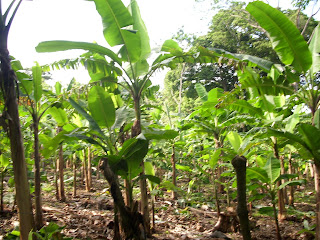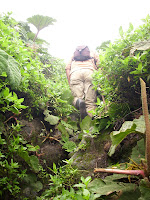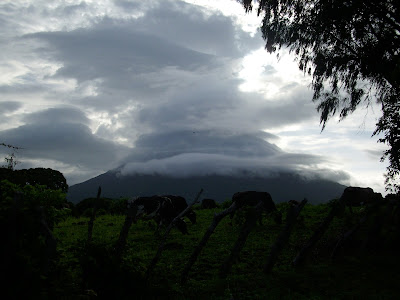This story is written in second-person to put you on the volcano. It takes place in the town of Altagracia, on Isla de Ometepe, Nicaragua.
You're living on an island made from two volcanoes in the middle of a fresh
lake in Nicaragua. You live with a
family in a house made of concrete. You
chase chickens from your room in the morning.
You sleep under a mosquito net. In
the mornings, you take a Spanish class in a different house. Sometimes you chase the chickens out of that room too.
Your spanish teacher tells you the island wasn't
made like other islands. Many years ago a man and a woman from different warring tribes
fell in love. Since their love was forbidden, Nagrando cut the wrists of
her lover, Ometepelt, then walked a hundred meters and cut her own. Her
body formed one volcanic island and their blood filled the lake. The other
island and its two volcanoes were formed from the chest of the Ometepelt.
“But
it’s funny,” says your Spanish teacher, “because one techo is bigger than the other.” In spanish techo means roof, but my teacher
means breast.
All
week you wonder which techo you will climb before you leave. Madera has a crater lake you can swim in. Concepcion is taller and active. You ask locals which they think is the best
but they loyally answer the same way, “Los
dos.” They also tell you to get a guide.
At night a young man named Yonas offers to
take you up a volcano for cheap. He has
a flat face and a thin mustache and he can’t stand up straight. The next day he doesn’t remember you and you
realize he was drunk.
The
other guide’s name is Ivan, but everyone calls him Hermanoso because he is “more
than a brother.” He speaks Spanish the
way you wished every Latino spoke: slowly.
No word ever rushes from his mouth, they come out in single file and then
linger in the audible space between you long enough that you can hear it, reach
out to grab it, digest and comprehend it, then wait for the next word. When he greets people he calls them Hermanaso to show fraternity. All this
inspires your trust more than Yonas did.
The
next day you take a bike ride to a beach. Everywhere you go Concepcion looms
over you. It is steep and intimidating. It is challenging you. It is also your local volcano, on your side
of the island. You decide which techo
you will climb.
Hermanaso tells you what to bring. Two liters of water. A snack. Sunscreen. Long pants. He tells you that it will be hard and you’ll
need to concentrate. You’re used to the
American style of overstating dangers and challenges, so you listen, but you don’t
hear him completely. Still, you bring
three liters of water and three sandwiches.

You
start the hike at 5:30 in the morning.
You walk out of town and onto a dirt road between lengths of farms.
The smell of plantain trees is strong.
Farmers on short horses pass you. There are
howler monkeys in the taller palms.
Hermanaso cups his hands over his mouth and talks to a monkey with
grunts and whoops.
The monkey talks
back.
“What
did you tell him?” you ask.
“Cuidate
en los arboles.” Be careful in the
trees.

At the entrance to the park you are sweating profusely.
You haven’t even
started the ascent yet.
There are two
other groups and guides.
A pair of
Dutchmen complain about their knees and then rush on.
A young British man grabs the whistle around
Hermanaso’s neck.
“So
we’re going to use this to call in the helicopter right?” You pay two dollars to enter the park and a
man gives you a complimentary walking stick.
You start hiking up.
The
forest around you is thick and the birdsong and howler monkeys form an
irregular chorus. Every sound is
singular, like you could pluck it from the air.
The trail turns to rock. It’s
made of small and big stones set in the dirt.
The gradient is, at places, 45 degrees.
This requires you to high-step and sometimes scale the rocks.
You
follow Hermanaso up, up, up. You exit
the thick cover of the forest where the volcano trades tall trees for
low-lying bushes and grass. The sun is
strong, but you’re two thousand feet above the island floor, so it’s cooler
too. You see Madera in the distance, the
whole island stretched out and from here you wonder if it’s always looked this
way. Altagracia is only a patch of
white dots below you, and the only proof that humans live here is you. You take pictures to reaffirm your delusion of strength. You finish half of your water.
 |
| Picture yourself flexing here |
Up, up, up. Hermanaso points out a special flower, Satyria, warszewiczii, a variety of the ericaceae family. He tells you it’s good for your energy and
then picks one and eats it.
You do the same. It is sour and
sweet with a squirt of water in each bite-sized blossom.
 You forage for other berries and
flowers and seeds. You climb another
1,000 feet. You start to get tired. Your feet drag. Your shirt is heavy with sweat like you had swam in a lake. You fall behind Hermanaso.
You forage for other berries and
flowers and seeds. You climb another
1,000 feet. You start to get tired. Your feet drag. Your shirt is heavy with sweat like you had swam in a lake. You fall behind Hermanaso.
When you catch up he’s waiting with
two small berries in the palm of his hand.
“These are for your spirit,” he
says, and you wonder if he just grabbed any berry and told you this to make you
make you feel better, but believing this won’t help, so you eat the berries and
think, yes, these are good for my
spirit.
“Vamos, Hermanaso,” Hermanaso says, which makes you feel good because now
he’s calling you Hermanaso, too.
Soon the rock trail
gets steeper and after another 1,000 feet you’re in the clouds walking in a
thin overgrown trail. The Dutchmen’s
guide, who had gone in front of you, cut a small corridor
with a machete because in the three days that no one hiked the trail the tropical plants
with leaves the size of your chest had overtaken it.
 You stop to eat sandwiches at a
vantage point where the sea and the sky look the same. Hermanaso suggests maybe we shouldn’t go to
the top. The gases could cause you
respiration problems later in life, he tells you. You can smell the sulfur, but you
also know the crater is only another 15 minutes away and it’s a long way to
climb to turn away now. But you also
recognize that as hard as it was going up, it will be harder, even dangerous,
going down.
You stop to eat sandwiches at a
vantage point where the sea and the sky look the same. Hermanaso suggests maybe we shouldn’t go to
the top. The gases could cause you
respiration problems later in life, he tells you. You can smell the sulfur, but you
also know the crater is only another 15 minutes away and it’s a long way to
climb to turn away now. But you also
recognize that as hard as it was going up, it will be harder, even dangerous,
going down.
You tell Hermanaso that this worries
you.
“You must think positively,” he
says. You convince Hermanaso to take you
to the top for only a minute to see the crater.
You hike through the sulfur
clouds. You can hardly see Hermanaso,
even when he is in front of you. 100 feet
from the top the thick leaves and bromeliads stop growing. The earth turns white.


When you are fifty
feet from the top, you can hear the Dutchmen.
They are standing at the rim of the crater rapping in English.
“We started from the bottom, now we’re
here. We started from the bottom now our
whole fuckin' team’s here.”
As you reach the top, you join them
in a verse and then stop, because you realize it’s not what you want to be
doing at the summit of a 5,000 foot climb.
You take pictures.
But your camera refuses to get past the smog.
It is thick and you start to cough from the
sulfur dioxides.
You get ready to
go.
The clouds shift for a moment and
reveal the crater.
It is deep and wide, pools of mud and water boil at
the bottom and thin towers of charred rock pimple the surface.
It looks like death.
You put your camera away, cover your mouth
with your shirt and leave.
The Dutchmen sit
on the rim and continue to laugh and rap.
They stay there for half an hour.
Hermanaso is upset that you went up
at all but he is too chill to be angry, so he just says, “Next time if there
are clouds like that, we won’t go to the top.”
You try to imagine a next time, but you can’t.
Just below the clouds you stop to
drink the rest of your water because you feel like you need to. The third group is eating and relaxing, a British guy,
American, and Australian girl. The
British guy asks you,
“If you were at the top of the
volcano and knew it was going to erupt in 15 minutes without any chance of
escape, what would you do?”
You say, “____________________________________
(what would you say... say it in the comment section)”
“That’s a good answer. You’re a
better man than me. I said have a wank
and eat a cheese sandwich.” The American
says he would have an orgy. The
Australian girl looks nervous. Later she
leaves her group.
 You follow Hermanaso
down, down, down. You go slow. You concentrate on every step.
You follow Hermanaso
down, down, down. You go slow. You concentrate on every step. This hike becomes the hardest hike of your
life.
It was steep going up, but,
inexplicably, it feels steeper going down.
After a few hundred feet your knees begin to buckle.
You become very thirsty.
You kill a fly that lands on your arm then
look around for the ghost of Chico Largo, a phantom in a black sombrero that
lives in the bottom of a lagoon but sometimes visits the mountain to protect
the flora and fauna from people.
You don’t
see him.
But you don’t kill another fly
either.
 When the flowers appear again, you
forage. Each blossom offers a tiny squirt
of water. You relish every drop. You hike another two thousand feet until you can
see town again, the static white speckles sprinkled in the green wood below, and
you can’t believe you are still so far away.
You take another picture of Hermanaso and gives you a look, so you take the rest more
furtively.
When the flowers appear again, you
forage. Each blossom offers a tiny squirt
of water. You relish every drop. You hike another two thousand feet until you can
see town again, the static white speckles sprinkled in the green wood below, and
you can’t believe you are still so far away.
You take another picture of Hermanaso and gives you a look, so you take the rest more
furtively.


Another 1,000 feet
and you’re losing energy. The Australian
girl passes you and suggests you eat something.
But you’re not hungry. You are
thirsty. You have never been thirstier
in your life. Your mouth is dry and
every step you take you sweat, losing more fluid. You lick your lips until they crack. You think  about combinations of beverages
awaiting you at the bottom in neat rows in shacks and markets. Gatorade, cola, juices, smoothies, water, ice
pops, cold beer, chocolate milk, ginger ale, coconut water, and you think about
this rest of the way, for three straight hours.
You don’t care about the views or the howler monkeys. When Hermanaso stops to tell you something
about a medicinal plant, you don’t listen.
You can’t. You don’t have the
energy to concentrate on information. He
gives you the last of his water. You forget
that it’s tap water, and you know your stomach will punish
about combinations of beverages
awaiting you at the bottom in neat rows in shacks and markets. Gatorade, cola, juices, smoothies, water, ice
pops, cold beer, chocolate milk, ginger ale, coconut water, and you think about
this rest of the way, for three straight hours.
You don’t care about the views or the howler monkeys. When Hermanaso stops to tell you something
about a medicinal plant, you don’t listen.
You can’t. You don’t have the
energy to concentrate on information. He
gives you the last of his water. You forget
that it’s tap water, and you know your stomach will punish  you for it later (and it
does for three days).
you for it later (and it
does for three days).
You pass the exit. You leave your walking stick behind. The ground starts to flatten. Your knees rejoice. You have another couple miles
to walk but the finish feels tangible, and now that you can feel the end you
have the energy to go on.

You kick a pink
flowery thing on the ground. Hermanaso
picks it up and it’s covered in dirt. You
think, dear God, Hermanaso, don’t ask me to eat that. Then he opens it up. Inside it’s filled with wet
jelly-like fruit. You eat all of it, and
it’s the best fruit you’ve ever had in your life (pitaya). Then he finds a starfruit from a tree and you
can feel some life to return to your body.
Hermanaso tells you that he wish he could hike the volcano three times a week but there are not enough tourists. At a clearing next to a farm Hermanaso stops you. He tells you to turn around and look. It is Concepcion, and it seems even bigger
now. It looks different now that you’ve
known been to its top.
“Look at that. We climbed that,” Hermanaso says. You feel so good you give Hermanaso a hug.
In town you drink, in order, an apple nectar
juice, a coca-cola, a half-liter of water, an ice pop, a liter of water, a
powerade, and then another liter of water.
At night you walk along your family’s street and it’s like you’re a
celebrity. Somehow everyone knows you,
the one white guy in town, the guy who climbed the volcano today. The restaurant owner now knows you and stops you. Young men drinking beer. A mom riding her bike. An old man with a glass eye sitting on a porch says to you in Spanish,
so you climbed Concepcion, and his
one good eye glimmers at you with charmed approval and you get to say, yes, yes, I did.
The next day you pack your bags to
leave town. This time you don’t chase
the chickens from your bedroom. You say
goodbye to your family and walk one block to the center of town.
Yonas,
drunk, tries to follow you. It is nine
on Sunday morning and he reeks of rum. He also knows you climbed the volcano, but without him.
He asks if you are friends and then calls you blanco and rich before falling onto
your shoulder and whispering into your ear, Help
me, please help me, and you’re sad that this is the last person you’ll see on the
way out of town.
Before
you board the bus you see Hermanaso. He
is sitting on the curb talking to his friends, calling each of them
Hermanaso. You hug and say
goodbye. He gives you a last lesson about medicinal flowers. You don't tell him that about the pain in your thighs. That you can't bend your legs. On the ferry, named Che
Guevarra, you meet the Dutchmen. They are in worse shape. They say they are going to a pool party to recover and that you should join them. You stand on the back of the boat to watch the volcano fade as you drift back to the mainland. You say to yourself, “I climbed that bad
motherfucker,” but also, “never again.”
 |
| Volcan Concepcion, Isla de Ometepe, Nicaragua |
 |
| The view from the ferry leaving Isla de Ometepe. Can you see it behind the clouds? |
 |
| Satyria, warszewiczii, a variety of the
ericaceae family |





























